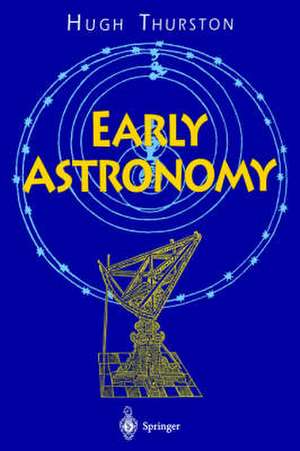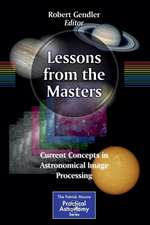Early Astronomy: Springer Study Edition
Autor Hugh Thurstonen Limba Engleză Paperback – 29 aug 1996
Din seria Springer Study Edition
-
 Preț: 386.26 lei
Preț: 386.26 lei -
 Preț: 370.79 lei
Preț: 370.79 lei -
 Preț: 296.06 lei
Preț: 296.06 lei -
 Preț: 403.37 lei
Preț: 403.37 lei -
 Preț: 508.91 lei
Preț: 508.91 lei - 23%
 Preț: 921.30 lei
Preț: 921.30 lei -
 Preț: 403.37 lei
Preț: 403.37 lei - 15%
 Preț: 502.73 lei
Preț: 502.73 lei -
 Preț: 389.70 lei
Preț: 389.70 lei - 5%
 Preț: 1122.94 lei
Preț: 1122.94 lei - 5%
 Preț: 370.38 lei
Preț: 370.38 lei -
 Preț: 406.25 lei
Preț: 406.25 lei - 15%
 Preț: 530.58 lei
Preț: 530.58 lei -
 Preț: 398.35 lei
Preț: 398.35 lei - 5%
 Preț: 368.73 lei
Preț: 368.73 lei - 15%
 Preț: 633.02 lei
Preț: 633.02 lei -
 Preț: 392.75 lei
Preț: 392.75 lei - 15%
 Preț: 588.69 lei
Preț: 588.69 lei - 20%
 Preț: 660.99 lei
Preț: 660.99 lei - 20%
 Preț: 663.61 lei
Preț: 663.61 lei - 15%
 Preț: 640.88 lei
Preț: 640.88 lei - 15%
 Preț: 654.43 lei
Preț: 654.43 lei -
 Preț: 390.46 lei
Preț: 390.46 lei - 15%
 Preț: 652.81 lei
Preț: 652.81 lei -
 Preț: 394.87 lei
Preț: 394.87 lei - 15%
 Preț: 642.03 lei
Preț: 642.03 lei - 15%
 Preț: 688.99 lei
Preț: 688.99 lei - 15%
 Preț: 642.36 lei
Preț: 642.36 lei - 15%
 Preț: 635.15 lei
Preț: 635.15 lei -
 Preț: 396.62 lei
Preț: 396.62 lei - 18%
 Preț: 893.21 lei
Preț: 893.21 lei -
 Preț: 419.14 lei
Preț: 419.14 lei -
 Preț: 423.34 lei
Preț: 423.34 lei - 20%
 Preț: 377.27 lei
Preț: 377.27 lei - 18%
 Preț: 742.97 lei
Preț: 742.97 lei - 15%
 Preț: 655.27 lei
Preț: 655.27 lei - 20%
 Preț: 336.02 lei
Preț: 336.02 lei -
 Preț: 397.38 lei
Preț: 397.38 lei
Preț: 389.70 lei
Nou
Puncte Express: 585
Preț estimativ în valută:
74.59€ • 81.05$ • 62.70£
74.59€ • 81.05$ • 62.70£
Carte tipărită la comandă
Livrare economică 21 aprilie-05 mai
Preluare comenzi: 021 569.72.76
Specificații
ISBN-13: 9780387948225
ISBN-10: 0387948228
Pagini: 268
Ilustrații: X, 268 p.
Dimensiuni: 155 x 235 x 14 mm
Greutate: 0.45 kg
Ediția:Softcover reprint of the original 1st ed. 1994
Editura: Springer
Colecția Springer
Seria Springer Study Edition
Locul publicării:New York, NY, United States
ISBN-10: 0387948228
Pagini: 268
Ilustrații: X, 268 p.
Dimensiuni: 155 x 235 x 14 mm
Greutate: 0.45 kg
Ediția:Softcover reprint of the original 1st ed. 1994
Editura: Springer
Colecția Springer
Seria Springer Study Edition
Locul publicării:New York, NY, United States
Public țintă
Professional/practitionerCuprins
1. Early Stargazers.- The Celestial Bowl.- The Constellations.- The Rotation of the Heavens.- The Sun.- The Moon.- The Planets.- The Stars.- The Astronomer’s Tools.- 2. Megalithic Astronomy.- Stonehenge.- Other Megalithic Structures.- 3. The Babylonians.- Early Period.- Sexagesimal Numerals.- Late Period.- 4. The Egyptians.- 5. The Chinese.- Chinese Units.- 6. The Greeks.- The Early Thinkers.- The Classical Greeks.- Hipparchus.- Ptolemy.- 7. The Astronomy of ?ryabha$$\mathop t\limits_.$$a.- The Sun.- The Moon.- The Planets.- Further Topics.- Unwritten Astronomy.- 8. Arabic Astronomy.- 9. The Mayas.- The Moon.- Venus.- Eclipse Table.- The Accuracy of the Maya Calendar.- 10. The European Renaissance.- Copernicus.- Tycho Brahe.- Kepler.- Appendix 1. Hipparchus’s Table of Chords.- Appendix 2. Calculation of the Eccentric-Quotient for the Sun, and the Longitude of its Apogee.- Appendix 3. Ptolemy’s Table of Chords.- Appendix 4. Calculating the Radius of the Moon’s Epicycle.- Appendix 5. The Eccentric-Quotient and Apogee of Mars.- Appendix 6. Reversed Epicycles.- Further Reading.- Sources of Information.













